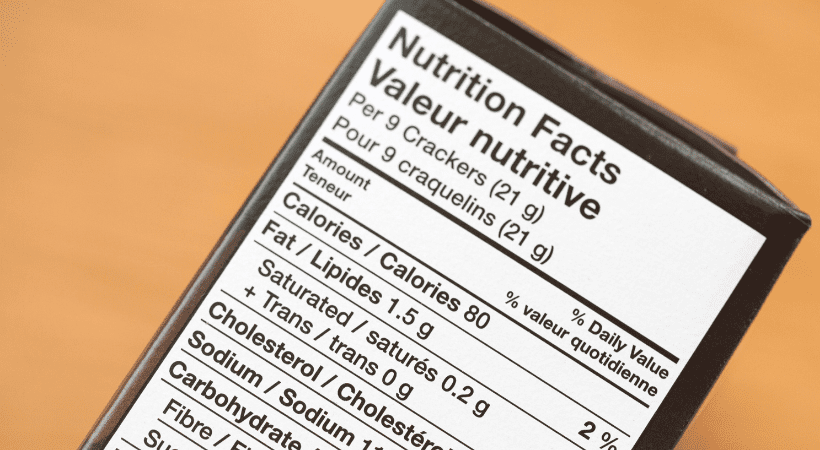Precautionary Allergen Labelling (PAL): How & When to Use it
Precautionary Allergen Labelling (PAL): How & When to Use it
Precautionary allergen labelling offers a protective measure in food labelling, used voluntarily by companies to inform consumers of potential allergen cross-contamination risks.
While most food businesses understand the importance of declaring allergens present in the food itself, many remain uncertain about how to appropriately use precautionary allergen labelling. In this article, we aim to demystify the subject and guide businesses in the accurate display of this information.
Table of Contents
What is Precautionary Allergen Labelling?
Precautionary allergen labelling is an optional practice, where food products are labelled to indicate the potential presence of allergens due to cross-contamination, despite not being ingredients in the product itself.
The phrase ‘may contain’ is often recognised, though the specific phrasing is flexible. While the Food Standards Agency (FSA) offers guidelines on using precautionary allergen labelling, it is not mandatory in the UK or the EU.
What Should a Precautionary Allergen Statement Say?
In the UK and the EU, there is no set formula for how precautionary allergen statements must be presented. We recommend using:
- ‘May contain X’
- ‘Not suitable for consumers with X allergy’
It’s advisable to avoid generic statements such as ‘may contain allergens’, as they don’t provide
enough information to be beneficial for consumers. Be specific, for example instead of ‘may contain nuts’ advise what nuts e.g. ‘May contain hazelnuts’.
Additionally, statements such as ‘Processed in the same facility as X’ should be avoided as they are not particularly useful to consumers. Clarity is crucial when it comes to food labelling compliance in general, and any form of precautionary allergen labelling should never confuse or mislead the customer.
When Should Precautionary Allergen Labelling Be Used?
Precautionary allergen labelling should be used only when there’s a genuine risk of allergen cross-contamination. Relying on precautionary allergen labelling without genuine risk can deter potential customers, limit the choice for those consumers living with allergens and be considered misleading.

Crucially, you cannot pair precautionary allergen labelling with ‘free from’ claims such as ‘may contain milk’ on a ‘free-from dairy’ product. However, precautionary allergen labelling can be combined with vegan claims under current UK food labelling regulations.
This is because the potential presence of allergens is a threat to human health, whereas the risk of a vegan product potentially containing non-vegan ingredients does not threaten health. In other words, a vegan consumer won’t fall ill or die from the presence of allergens, but an allergenic consumer might.
Common errors with PAL to watch out for
The primary pitfalls of precautionary allergen labelling for the food producer are:
- Not assessing correctly where contamination of food by allergens may occur.
- Not transferring allergen risk from suppliers’ data sheets to your own risk assessment procedure. There is no consensus in the food industry about when to use precautionary allergen labelling, other than the guidance to use when the risk cannot be removed.
- Including all allergens on site in the PAL warning, even if precautions have been made to ensure cross-contamination does not occur. This can lead to allergic consumers taking risks by eating products with a PAL because PAL statements are so common and limit their food choices so much that, if eaten once without incident, they may risk eating this or other foods labelled with a precautionary allergen label.
- The use of rework, which may contain an allergen, into a product that is not appropriately labelled.
The primary pitfalls that consumers may face are:
- Assuming that a vegan product is free from milk, egg, fish, molluscs and crustaceans.
- Ignoring ‘may contain’ statements owing to inappropriate and overuse of the warning by manufacturers
- Inability to comprehend the level of risk owing to manufacturers using different risk assessment strategies and different warnings on packaging.
The Food Standards Agency, in association with their counterparts in New Zealand and Australia, conducted a review of scientific studies into many aspects of allergen labelling including precautionary allergen labelling. The review concluded that PAL was often ignored, was found confusing by some and was most beneficial when specific allergens were included in the PAL.
Reducing the Risk of Allergen Cross-Contact

Cross-contact occurs when allergens unintentionally transfer from one substance to another. This could be related to where the food is grown, how it’s processed, manufactured or prepared for consumption. To mitigate this risk food manufacturers ought to consider the following:
HACCP (Hazard Analysis and Critical Control Points)
HACCP is a preventive approach to food safety. As far as allergens are concerned, it identifies potential allergen hazards in production and sets procedures to control them.
Key steps include hazard identification, determining critical control points where hazards can be managed, setting limits for these points, consistent monitoring, staff training and defining corrective actions.
Storing and processing allergenic ingredients separately
Prevent cross-contamination by designating storage areas specifically for allergenic ingredients. Ensure these sections are clearly labelled and that allergens cannot be transferred to other areas of the production site via clothing, equipment or air currents for example. Continuous staff training ensures that they are adhering to these storage practices and understand the consequences of deviations.
Many manufacturers will dedicate specific sites as allergy-free, only producing free-from lines here to prevent the chance of cross-contamination during processing. They may also not allow employees to bring high-risk allergenic materials like nuts or products containing nuts onto the site and not just production lines, this includes rest facilities and changing rooms where outside clothing is kept.
Cleaning
Maintain a contamination-free environment by establishing regular cleaning schedules, especially for equipment that comes into contact with allergens. Using separate cleaning tools for allergen-rich areas and allergen-specific cleaning agents is recommended. Post-cleaning rapid allergen swabbing of recently cleaned areas is also vital to ensure that specific allergens have been removed. This is different to the post-cleaning ATP swabbing conducted to ensure effective cleaning has been carried out.
Hygiene
Personal hygiene is crucial in allergen management. Implement strict hand-washing protocols, especially post-allergen handling. Staff should use personal protective equipment (PPE) when interacting with allergens and be continuously educated on the importance of hygiene in allergen prevention.
The Future of Precautionary Allergen Labelling
The ambiguity of PAL has led to it being a focus on the development of relevant standards.
The Food Standards Agency (FSA) ran a consultation in May 2023, on proposed updates to Food Allergen Labelling and Information Requirements Technical Guidance. Responses suggested an industry shift towards standardised labelling methods and wording – such as ‘not suitable for XXX allergies’ and specifying the allergen rather than generic statements (e.g. ‘May contain peanuts’ rather than ‘May contain nuts’) to ensure clarity for consumers. Information on how businesses should use PAL in combination with vegan labelling is also included. The guidance was updated to reflect responses in August 2023.
Meanwhile, the VITAL (Voluntary Incidental Trace Allergen Labelling) programme, a collaboration between scientists and manufacturers, is introducing a more scientific approach. VITAL quantifies threshold levels for allergens to guide manufacturers in creating informed precautionary statements based on measurable risk. The threshold level would be the same for all so precautionary allergen labelling would be comparable across brands. These thresholds will be safe for the vast majority of allergen sufferers, however, there is concern that there will be a tiny number of hypersensitive individuals for whom the threshold levels may be too high.
Codex Alimentarius is also expected to publish new guidance or amendments to existing codex standards for PAL, considering research on threshold levels and labelling best practices. Whilst not legally binding, the standards provide a base for individual countries to develop legislation.
As consumer awareness grows, there’s a push for transparency in food labelling. Precautionary allergen labelling will likely merge strict regulations, science-driven data, and rising consumer expectations. Brands may increasingly turn to third-party testing to validate their allergen claims, promoting consumer trust.
Support with Precautionary Allergen Labelling
If there remains a genuine risk of allergen cross-contamination after adopting these best practices, it is crucial to inform consumers via precautionary allergen labelling.
Our food labelling compliance experts at Ashbury are here to guide you through the process. With extensive experience, Ashbury can offer tailored advice for your business regarding when and how to use precautionary allergen labelling.
Contact us today to ensure that your business is compliant and putting the safety of your consumers first.

Author: Janet Dalzell
My 30 years of experience in food regulatory and technical roles is invaluable in providing clear answers to client's queries. My background covers all foods but particularly botanicals, produce, dairy and beverages, in addition to which I have a keen interest in sustainability.
Next reads
The Peanut Diaries: School and Social Occasions
The Peanut Diaries: Navigating Social Events and Celebrations with Food Allergies
The Peanut Diaries: A Parent’s Journey to Uncovering their Child’s Allergy
Redefining Healthy: What the FDA’s New Rules Mean for Food Labels and Nutrition Claims
Keep up to date with our latest insights
Subscribe to our mailing list to stay in touch with the latest news, insights and updates from Ashbury




